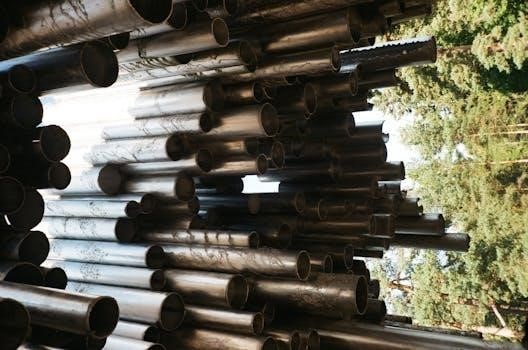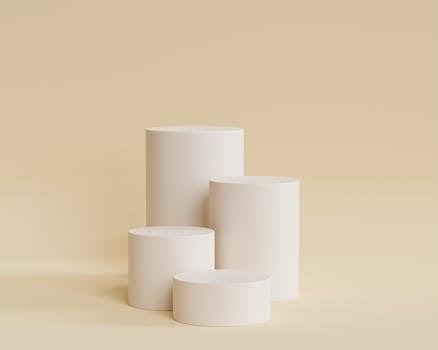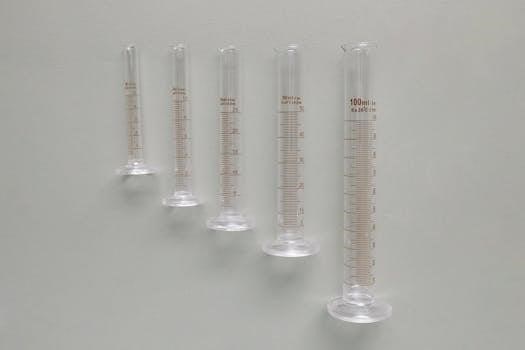
-
By:
- ophelia
- No comment
volume of cylinder worksheet pdf
Volume of Cylinder Worksheet PDF⁚ A Comprehensive Guide
This comprehensive guide will equip you with the tools to understand and master cylinder volume calculations.
Explore various resources, including free PDF worksheets designed for different skill levels, from grade 8
to high school, complete with answer keys and solutions for effective learning.
Understanding Cylinder Volume
Understanding cylinder volume is crucial in various fields, from engineering to everyday problem-solving. A
cylinder, a fundamental geometric shape, is defined by its circular base and consistent height. Grasping the
concept of volume, which measures the three-dimensional space occupied by the cylinder, is essential.
This involves recognizing that the volume represents the amount of substance a cylinder can hold.
Visualizing a cylinder as a stack of circular discs can aid in understanding its volume. Each disc contributes
to the overall volume, and the total volume is the sum of all these discs. Understanding the relationship
between the cylinder’s dimensions—radius and height—and its volume is paramount. Worksheets often provide
visual aids and practical exercises to reinforce this understanding. These exercises help solidify the
foundational knowledge needed to tackle more complex problems involving cylinder volume calculations.
Formula for Volume of a Cylinder
The formula for calculating the volume of a cylinder is fundamental in geometry and practical applications.
It’s expressed as V = πr²h, where V represents the volume, π (pi) is a mathematical constant
approximately equal to 3.14159, r is the radius of the circular base, and h is the height of the cylinder.
This formula elegantly combines the area of the circular base (πr²) with the height to determine the total
space enclosed within the cylinder.
Understanding the origins of this formula helps in its application. The area of the base represents the
two-dimensional space of the circle, and multiplying it by the height extends this area into the third
dimension, giving the volume. Worksheets often include exercises that require students to apply this
formula in various scenarios. Mastery of this formula is crucial for solving problems related to cylinder
volume and forms the basis for more advanced geometric calculations.
Components of the Formula (Radius and Height)
The formula for the volume of a cylinder, V = πr²h, relies on two key components⁚ the radius (r) and the
height (h). The radius is the distance from the center of the circular base to any point on its circumference.
It is a critical measurement because the area of the base, πr², is directly dependent on it. A small change
in the radius can significantly affect the calculated volume due to the squared term.
The height, denoted as h, represents the perpendicular distance between the two circular bases of the
cylinder. It essentially extends the two-dimensional area of the base into a three-dimensional space,
defining the cylinder’s volume. Worksheets often provide exercises where students must identify or
calculate the radius and height from given information.
Accurately determining these components is essential for correct volume calculation. Exercises may involve
converting diameters to radii or using geometric properties to find the height.

Calculating Volume⁚ Example Problems
Explore example problems that enhance your understanding of cylinder volume calculations. These examples cover simple calculations, unit conversions, and advanced problems involving volume and other geometric properties, all designed to solidify your skills.
Simple Calculation Examples
Let’s delve into some straightforward examples to illustrate calculating the volume of a cylinder. These problems typically provide the radius and height directly, requiring you to apply the volume formula⁚ V = πr²h. For instance, consider a cylinder with a radius of 5 cm and a height of 10 cm.
To find the volume, square the radius (5² = 25), multiply by π (approximately 3.14159), and then multiply by the height (10). This yields a volume of approximately 785.4 cm³.
Another example⁚ a cylinder has a radius of 2cm and a height of 5cm. Calculate the volume⁚ V = π * (2cm)² * 5cm = π * 4cm² * 5cm = 20π cm³ ≈ 62.83 cm³.
These basic examples build a foundation for tackling more complex problems. Practice with various radius and height values to reinforce your understanding. Remember to always include the appropriate units (e.g., cm³, m³) in your final answer.
Examples with Unit Conversions
Moving beyond simple calculations, let’s explore examples that require unit conversions. These problems introduce an extra layer of complexity, ensuring a deeper understanding of volume calculations. For instance, imagine a cylinder with a radius of 0.2 meters and a height of 50 centimeters.
Before applying the volume formula, you must convert both measurements to the same unit. You can convert meters to centimeters (0.2 meters = 20 centimeters) or centimeters to meters (50 centimeters = 0.5 meters). Choosing centimeters, the volume would be V = π * (20cm)² * 50cm = 62831.85 cm³.

Alternatively, using meters, the volume would be V = π * (0.2m)² * 0.5m = 0.0628 m³. Remember that 1 m³ equals 1,000,000 cm³, so both results are equivalent. These examples emphasize the importance of consistency in units.
Practice various problems involving millimeters, centimeters, meters, and even inches and feet to master unit conversions. These skills are crucial for real-world applications.
Advanced Problems Involving Volume and Other Properties
To truly master cylinder volume, delve into advanced problems that intertwine volume with other geometric properties such as surface area or density. For instance, consider a problem where you’re given the volume of a cylinder (e.g., 500 cm³) and its radius (e.g., 5 cm). You need to find the height.
Using the formula V = πr²h, rearrange it to solve for h⁚ h = V / (πr²). Plugging in the values, h = 500 / (π * 5²) ≈ 6.37 cm. Now, let’s add another layer⁚ If the cylinder is made of a material with a density of 2.7 g/cm³, find its mass.
First, use the volume (500 cm³) and density (2.7 g/cm³) to find the mass⁚ mass = density * volume = 2.7 g/cm³ * 500 cm³ = 1350 grams.
Such problems enhance your problem-solving abilities. You’ll encounter scenarios involving ratios, proportions, and algebraic manipulation, reinforcing a comprehensive understanding of mathematical concepts. These challenges are perfect for high school students seeking to excel.

Applications of Cylinder Volume
Cylinder volume calculations extend beyond textbooks, finding practical applications in various real-world scenarios.
From determining the capacity of oil drums to calculating the flow rate in pipes, understanding cylinder volume is essential.
Real-World Examples (Oil Drums, Pipes, etc.)
The concept of cylinder volume transcends theoretical math, embedding itself deeply in numerous practical applications.
Consider the ubiquitous oil drum, its capacity directly determined by its cylindrical dimensions. Understanding its volume is crucial for storage and transportation logistics.
Similarly, pipes, essential components of plumbing and industrial systems, rely on cylinder volume calculations to determine flow rates and material capacity.
Engineers use these principles to design efficient and reliable systems.
Calculating the volume of cylindrical containers is vital in manufacturing, ensuring accurate filling and packaging of products.
From food processing to chemical industries, precision in volume measurement is paramount for quality control and regulatory compliance.
Moreover, understanding cylinder volume plays a role in architecture and construction.
Estimating the amount of concrete needed for cylindrical pillars or the capacity of cylindrical water tanks requires accurate volume calculations.
These real-world examples illustrate the pervasive relevance of cylinder volume in various fields, emphasizing its importance in both everyday life and specialized industries.
The ability to calculate cylinder volume accurately is a valuable skill, applicable across diverse disciplines and essential for problem-solving in practical scenarios.
Practical Uses in Geometry and Math Education
The study of cylinder volume extends beyond rote memorization of formulas, serving as a cornerstone in geometry and math education.
It provides students with a tangible application of geometric principles, bridging the gap between abstract concepts and real-world scenarios.
Calculating cylinder volume reinforces the understanding of area, particularly the area of a circle, which forms the base of the cylinder.
Students learn to apply the formula for the area of a circle (πr²) in a three-dimensional context, enhancing their spatial reasoning skills.
Furthermore, working with cylinder volume introduces the concept of units and unit conversions;
Students practice converting between different units of measurement, such as centimeters and meters, developing their proficiency in dimensional analysis.
Solving problems involving cylinder volume also hones problem-solving abilities.
Students learn to break down complex problems into smaller, manageable steps, applying logical reasoning and mathematical operations to arrive at a solution.
Moreover, the study of cylinder volume provides a foundation for more advanced topics in calculus and engineering.
Understanding volume calculations is essential for comprehending concepts such as integration and optimization, which are fundamental in these fields.
By exploring the practical uses of cylinder volume, students gain a deeper appreciation for the relevance of mathematics in their lives, fostering a greater interest in STEM fields.

Resources for Cylinder Volume Worksheets
Discover a wealth of resources for cylinder volume worksheets, including free PDF downloads.
Find worksheets tailored for various skill levels, from grade 8 to high school, complete with answer keys and solutions for effective practice.
Free PDF Worksheets Online
Access a wide array of free PDF worksheets online designed to help students master the concept of cylinder volume. These worksheets cater to different skill levels and learning styles, making them ideal for both classroom instruction and independent practice. Many websites offer printable worksheets that cover various aspects of cylinder volume calculation, from basic formula application to more complex problem-solving scenarios involving unit conversions.
These free resources often include answer keys, allowing students to check their work and reinforce their understanding. Look for worksheets that provide a mix of straightforward calculations and word problems to challenge students and help them apply their knowledge in real-world contexts. Some websites also offer interactive worksheets that provide immediate feedback, enhancing the learning experience.
Explore resources from educational websites, math tutorial sites, and teacher resource platforms to find a diverse collection of free PDF worksheets for teaching and learning cylinder volume.
Worksheets for Different Skill Levels (Grade 8, High School)
Cylinder volume worksheets are available for diverse skill levels, ranging from grade 8 to high school. These resources are tailored to meet the specific needs of students at each stage of their mathematical development. For grade 8 students, worksheets often focus on basic calculations and simple applications of the volume formula.
High school worksheets delve into more complex problems, including those that involve unit conversions, algebraic manipulation, and real-world scenarios. These advanced worksheets may also incorporate concepts such as surface area and composite figures, challenging students to apply their knowledge in a more comprehensive manner.
Teachers can select worksheets based on their students’ proficiency levels, ensuring that the material is both challenging and accessible. Worksheets designed for different skill levels help students build a strong foundation in cylinder volume and prepare them for more advanced mathematical concepts.
Look for resources that offer a variety of worksheet types to cater to different learning styles and instructional goals.
Answer Keys and Solutions
Answer keys and comprehensive solutions are essential components of effective cylinder volume worksheets. These resources provide students with the ability to check their work and identify areas where they may need additional support. Answer keys typically include the correct numerical answers to each problem, allowing students to quickly assess their understanding of the concepts.
Solutions, on the other hand, offer a step-by-step breakdown of the problem-solving process. These detailed explanations demonstrate how to apply the volume formula, perform necessary calculations, and arrive at the correct answer. Solutions are particularly valuable for students who are struggling with the material, as they provide a clear roadmap for approaching similar problems in the future.
Teachers also benefit from having access to answer keys and solutions, as they can use these resources to quickly grade assignments and provide targeted feedback to their students. Furthermore, solutions can serve as a valuable teaching tool, allowing teachers to model effective problem-solving strategies in the classroom.
When selecting cylinder volume worksheets, be sure to prioritize those that include both answer keys and detailed solutions.